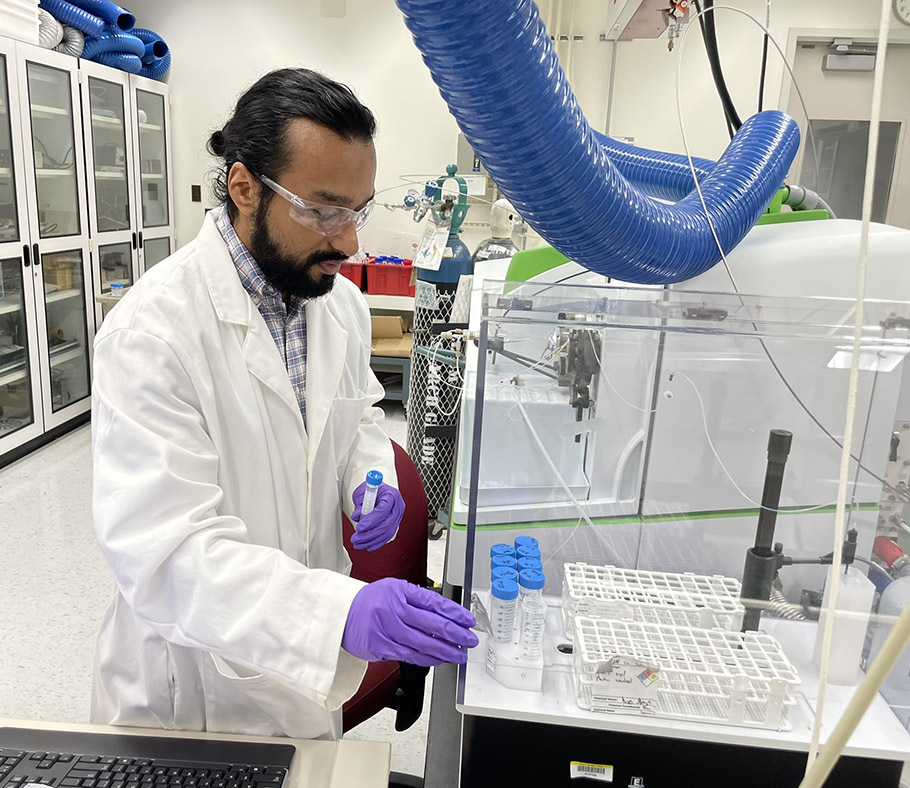Taking Measure
Just a Standard Blog
Measuring Microplastics: To Solve the Problem, We Have to Understand and Measure It

There is increasing concern about microplastics' effect on the environment and our health. NIST student researcher George Caceres is working to develop instruments that can help measure tiny microplastics — so we can better understand the risks.
Because I’m a microplastics researcher, my friends sometimes jokingly ask me, “How many microplastics do you think I consumed this week?”
I can’t give an exact answer. Unfortunately, the answer is not zero.
Microplastics — the tiny plastic particles that break down from plastic products — are everywhere. And they are on a lot of people’s minds, which is why people ask me about them.
If we want to address microplastics, we need to understand them and be able to measure them properly. That’s what I’m doing as a Ph.D. student researcher at NIST and the University of Maryland.
I’m working to develop instruments that can help measure tiny microplastics. How small? While microplastics vary in size, the range of particles I work with is between 1 micrometer (a millionth of a meter) and 5 micrometers. To give you an idea of how small that is, a human hair’s width is typically 17-180 micrometers.
To study these particles, I use a tool that can help researchers measure and understand elements in plastics and other items. This tool is known as single particle inductively coupled plasma mass spectrometry (spICP-MS). Current techniques don’t measure the tiniest particles and don’t work with all types of microplastics. The long-term goal of my research is to expand the measurement technologies to a wide variety of particles and those of smaller sizes.
Currently, I’m working on tools to analyze carbon in tiny plastics. Plastic polymers are primarily made up of carbon-based compounds. So, to measure microplastics, we need to better understand one of their main “ingredients” — carbon.
But carbon is everywhere in our environment, and it’s very difficult to measure it, specifically in microplastics. Instead of looking for the proverbial needle in the haystack, it’s like looking for a particular piece of hay in a haystack. There’s lots of what we call “noise” from the surrounding carbon in the environment, making this a challenging project.
While carbon is a major element of plastic, it’s not the only element. There are other compounds added to plastic in the form of additives that give plastic desirable properties. As these plastics break down, these additives stay with the microplastic particles. We can then try to use these additives to make measurements of microplastics for a different way to assess environmental and health impacts, in addition to other key properties of these particles.
Once we have a more complete baseline understanding of carbon, we’ll move on to the potentially even more difficult project of measuring these additive elements.

From Tinkerer to Microplastics Measurer
Ever since I was a kid, I’ve loved building, tinkering and figuring out how things work. I loved to build Lego models and would, at times, disregard the instructions just to make my own creations. I routinely took things apart, particularly electronics, just to figure out how they were configured or how they worked. Once I was satisfied, I would put them back together, even if I was not always successful. To this day, I enjoy building desktop computers and will always try a repair job on my own purely for my own curiosity.
My love of discovery and learning has also translated into an immense interest in how things work in the environment and in the world. So, I figured science would be an ideal career.
I got my undergraduate degree in biochemistry and did internships here at NIST. I’ve continued on through my Ph.D. program at NIST through NIST’s Professional Research Experience Program (PREP). PREP has been an amazing experience for me and has made me want to continue my career in research here at NIST after I get my Ph.D.
One of the things I love most about my job is being able to modify instruments and adapt them to study microplastics — since I am a tinkerer.
Many Effects of Microplastics Remain Unknown
This work is important to me because we need to understand the extent of microplastics’ effect on the environment and our health.
For example, there is increasing concern in the research community about how plastics interfere with our environment, such as the effects of toxic elements leaching from the plastics or what happens to soil or water when plastics accumulate there.
To answer these questions, we need to have more robust methods to measure and understand what’s happening with microplastics.
While microplastics are a huge problem, there’s also a dedicated group of scientists and researchers who want to help solve it. Being a part of this community that’s doing such amazing work trying to push this research forward and find solutions really keeps me motivated.
Taking Microplastics Research From the Lab to the Lake
This research is still in its earliest stages, but we have some goals to learn even more about microplastics in the future.
Right now, we’re still mostly working with pristine plastic samples. We take samples from household products and grind them up into a fine powder. We then put them into a liquid solution that preserves the particles for analysis. But out in the world, plastic gets wet, dirty or damaged. We need to be able to measure plastic as it actually exists in the environment.
We hope to refine our techniques to the point that we can collect a sample from a river or other area in nature to study how microplastics are affected by the natural environment. I hope to establish this method as viable enough that we could collect some of those challenging, real-world samples and be able to study them the same way, using these microplastic analysis techniques I use on pristine samples.
While addressing the issue of plastic pollution and microplastics may seem insurmountable, it is certainly achievable. Researchers like me are hard at work trying to find innovative solutions and technologies that give us a better understanding of these plastic materials. Our hope is that other researchers can continue to develop techniques and tools to address the plastics crisis — both for the health of humans and our planet.
About the author
Related posts
Comments
Very impressive work. Great initiative.
If u eventually do make the technology to measure microplastics, please share it to the world. Especially me. So I can do my research paper. Thank you for your great contributions, this is wonderful to see!
Dear George,
Hi, your work sounds fascinating and SO relevant at the moment!
I wonder if you could help me though? I live in London and the water quality is terrible. We have recently started buying water from as far away as the Cotswolds and Scotland and each company water-provider claims their product is microplastic free. This MAY be the case at source, but by the time it gets bottled (in soft plastic bags for one company, in harder plastic 19L bottles for another), I'm sure that won't be the case!
So, my question is: what would be the best way to get the water tested for microplastics? There just doesn't seem to be a home test kit on the market and I have no idea about laboratories where I could send samples to. Could you help?
Many thanks!
Milton






Fascinating topic George and NIST. Keep up the good work!!